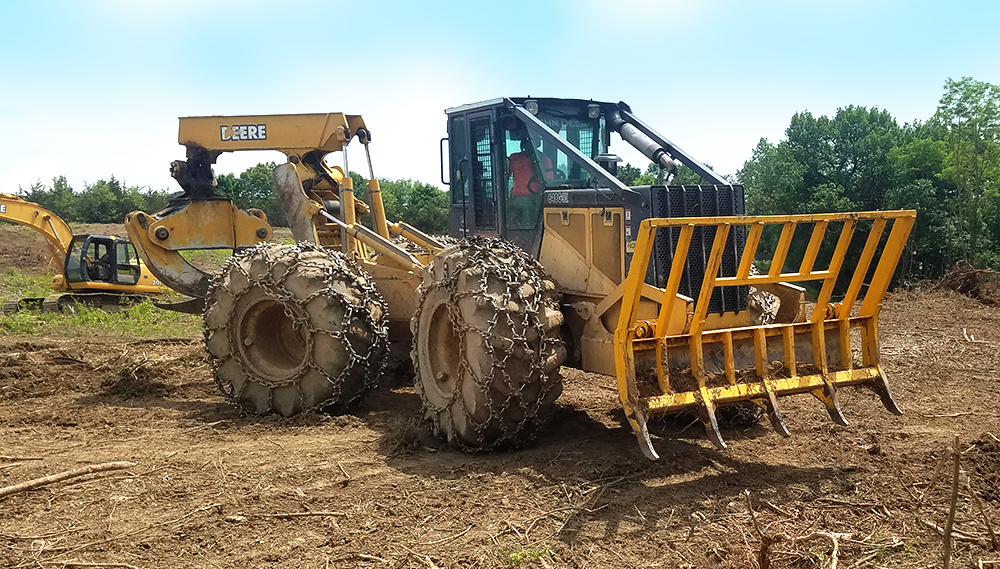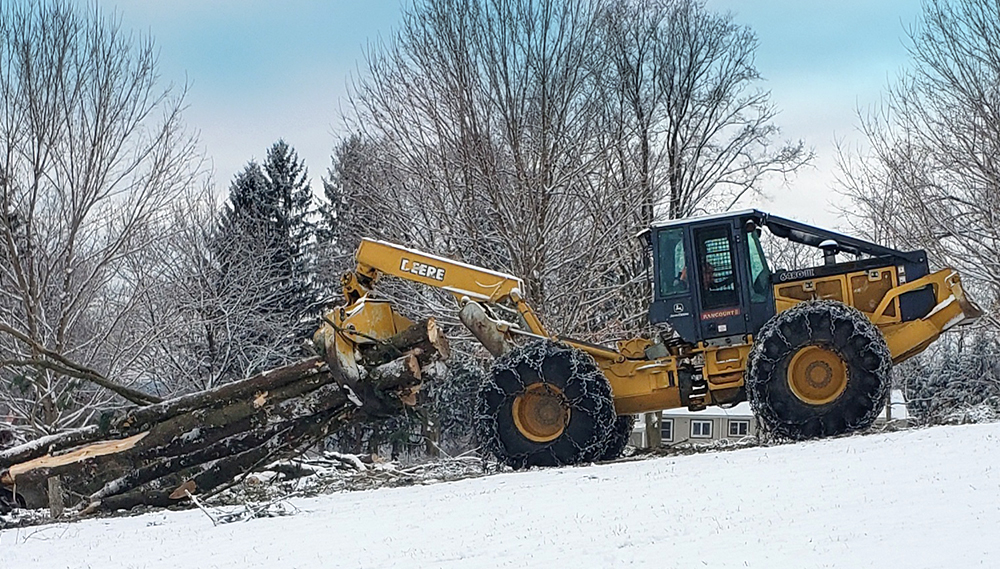Rancourt Grapple Skidder
A skidder is required after a feller buncher has completed cutting and stacking trees. Our John Deere Grapple Skidder is primarily used for dragging and transporting hitches or piles of trees to our Whole Tree Chip harvester for chipping. The skidder is also used for moving and stacking logs on a land clearing project.

Rancourt Grapple Skidder
One of the first original tools in forestry operations is a Grapple Skidder.
This machine is equipped with a winch which can be used to drag trees from areas that are not accessible by heavy equipment or machines. The winch is also used to assist with the directional felling of trees.
Trees along a roadway can simply be pulled back during the cutting process with the winch. We also have a root rake for the skidder, which is used for collecting brush and moving stumps. The skidder has many valuable uses on a site and is an important piece of the puzzle for efficient land clearing operations. Contact Us for more information on our Grapple Skidder Services.
What is Directional Felling?
The directional notch determines the direction of fall, and you fell the tree with the felling cut. Left between these two cuts is the hinge, which directs the tree down to the ground towards the planned directional target in a safe way.
Felling is the process of cutting down trees, an element of the task of logging. The person cutting the trees is a feller. A feller buncher is a machine capable of felling a single large tree or grouping and felling several small ones simultaneously.
What are the Fastest Growing Trees?
Some of the most popular trees are fast growing trees. Fast growing trees give homeowners the opportunity to realize the benefits of a mature tree sooner. Individuals seem to especially focus on using fast growing shade trees and fast growing hedges in their landscape to reap the benefits of these value added landscape design practices sooner. Once these trees are properly planted and established, these trees will grow several feet per year.
Here are some of the fastest growing trees available. Please note, a solid root system will go a long way in helping trees to grow faster and good annual pruning practices will help maximize the potential of your tree.
Hybrid Poplar: A very fast-growing tree, up to 5 to 8 feet per year. A versatile tree that can be used as a deciduous screen, shade tree to reduce energy cost, and often planted in rows for firewood.
Weeping Willow: Depending on the cultivar weeping willow trees can grow from 3 to 8 feet per year, making it one of the fastest of the fast growing trees. Salix babylonica will grow 3 feet per year.
Quaking Aspen: This speedy growing tree is a member of the same family as Hybrid Poplar. It averages 2 to 3 feet of growth per year and adds value to any landscape because of tremendous fall color.
October Glory Red Maple: The fast growing red maple cultivar has been bred for brilliant fall foliage. See Julie Walton Shaver growth rate chart and pictures of her October Glory Red Maple tree from 1999 to 2006.
Arborvitae Green Giant: Growing up to 3 feet a year this hybrid is an exceptional landscape tree for use as a screen, hedge, windbreak, or single specimen.
River Birch: Known for its unique bark, fall color, and bird habitat the River Birch is also one of the fastest growing birches. Betula nigra can grow up to 1.5 to 2 feet per year in ideal conditions.
Dawn Redwood: On good sites, its growth is rapid, with a tree in Virginia reaching 120 feet in 30 years or an average of 4 feet per year.
Leyland Cypress: This rapidly growing evergreen can easily grow 3 feet per year and has a great column shape making it an extremely popular tree in home landscape design.
Paper Birch: This extremely popular fast growing tree has been known to grow at 1.5 to 2 feet per year.
Pin Oak: A large shade tree that quickly reaches its 70 foot height with an average growth rate of 2.5 feet per year.
SOURCE: Arbor Day Foundation


